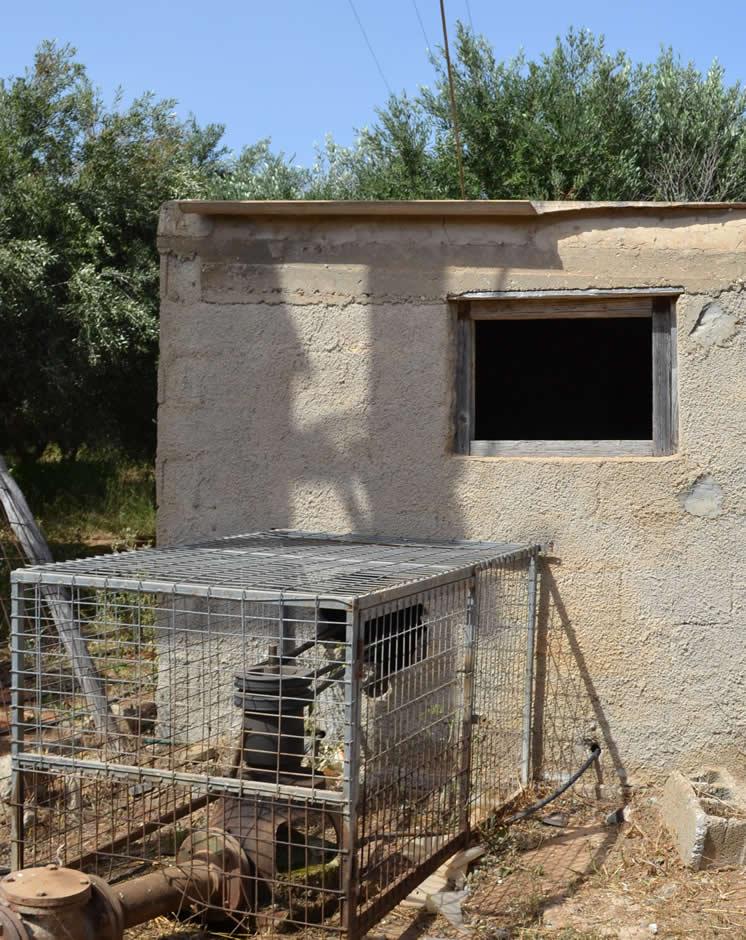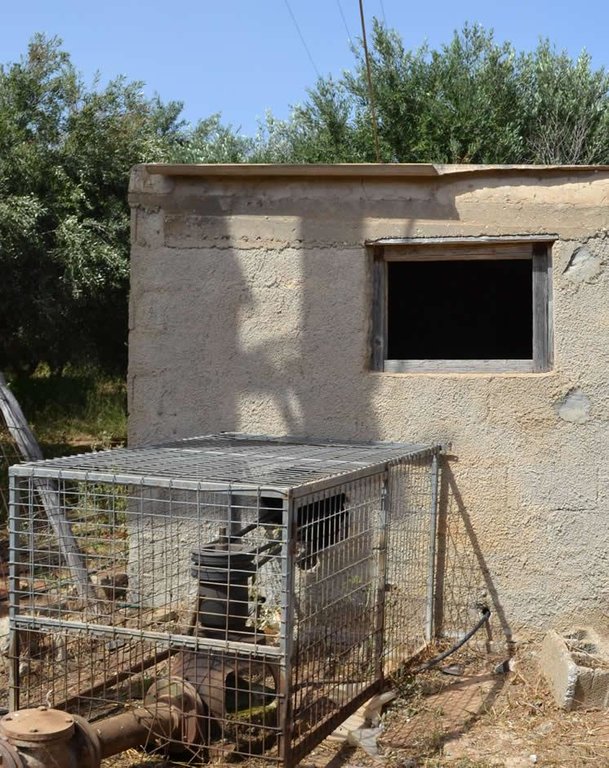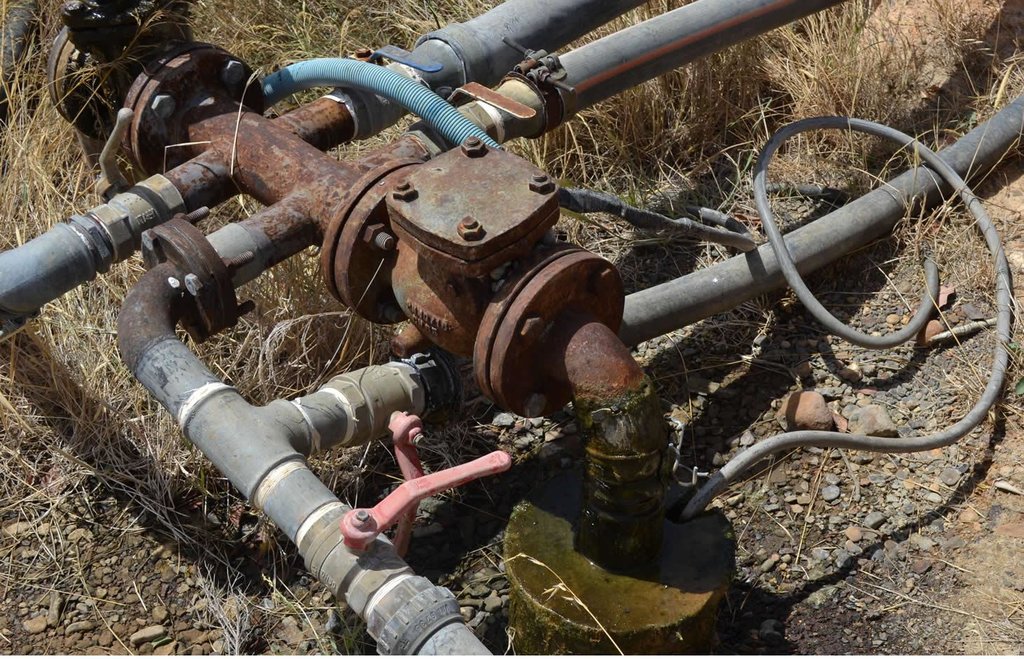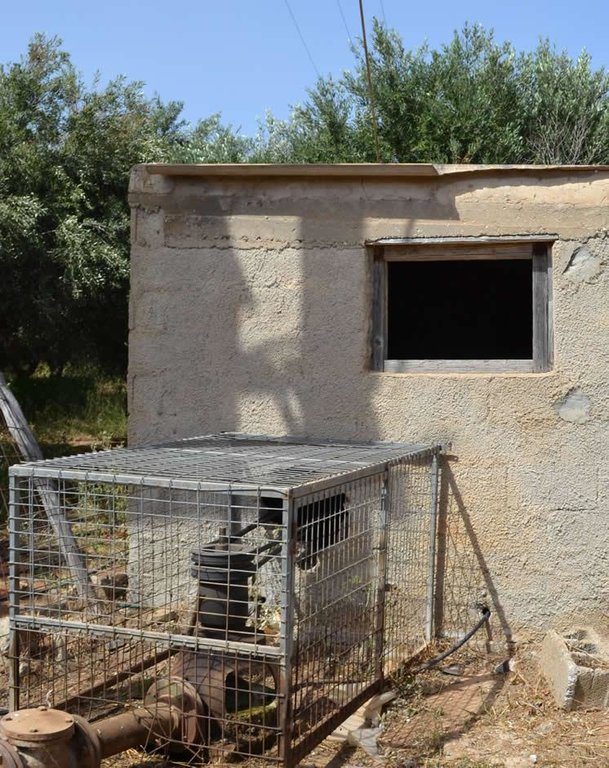Cooperative for Drilling and Exploiting a Private Water Well [ប្រទេសក្រិក]
- ការបង្កើត៖
- បច្ចុប្បន្នភាព
- អ្នកចងក្រង៖ Ioannis Daliakopoulos
- អ្នកកែសម្រួល៖ –
- អ្នកត្រួតពិនិត្យ Fabian Ottiger
Συνεταιρισμός με Σκοπό την Εγκατάσταση και Λειτουργία Ομαδικής Γεώτρηση
approaches_2619 - ប្រទេសក្រិក
ពិនិត្យមើលគ្រប់ផ្នែក
ពង្រីកមើលទាំងអស់ បង្រួមទាំងអស់1. ព័ត៌មានទូទៅ
1.2 ព័ត៌មានលម្អិតពីបុគ្គលសំខាន់ៗ និងស្ថាប័នដែលចូលរួមក្នុងការវាយតម្លៃ និងចងក្រងឯកសារនៃវិធីសាស្ត្រផ្សព្វផ្សាយ
អ្នកជំនាញឯកទេស SLM:
អ្នកជំនាញឯកទេស SLM:
ឈ្មោះគម្រោងដែលបានចងក្រងឯកសារ/ វាយតម្លៃលើវិធីសាស្ត្រផ្សព្វផ្សាយ (បើទាក់ទង)
Preventing and Remediating degradation of soils in Europe through Land Care (EU-RECARE )ឈ្មោះអង្គភាពមួយ (ច្រើន) ដែលបានចងក្រងឯកសារ/ វាយតម្លៃលើវិធីសាស្ត្រផ្សព្វផ្សាយ (បើទាក់ទង)
Technical University of Crete (Technical University of Crete) - ប្រទេសក្រិក1.3 លក្ខខណ្ឌទាក់ទងទៅនឹងការប្រើប្រាស់ទិន្នន័យដែលបានចងក្រងតាមរយៈវ៉ូខេត
តើពេលណាដែលទិន្នន័យបានចងក្រង (នៅទីវាល)?
13/12/2014
អ្នកចងក្រង និង(បុគ្គលសំខាន់ៗ)យល់ព្រមទទួលយកនូវលក្ខខណ្ឌនានាទាក់ទងទៅនឹងការប្រើប្រាស់ទិន្នន័យដែលបានចងក្រងតាមរយៈ វ៉ូខេត:
បាទ/ចា៎
2. ការពណ៌នាអំពីវិធីសាស្ត្រផ្សព្វផ្សាយ SLM
2.1 ពណ៌នាសង្ខេបខ្លីពីវិធីសាស្ត្រផ្សព្វផ្សាយ
A cooperative of land owners and at least one water rights owner established to jointly establish and manage a private freshwater well.
2.2 ពណ៌នាលម្អិតពិវិធីសាស្ត្រផ្សព្វផ្សាយ
ពណ៌នាលម្អិតពិវិធីសាស្ត្រផ្សព្វផ្សាយ:
Aims / objectives: The approach is implemented for deep water wells where installation costs are high. It provides an option for land owners to abandon their low quality shallow wells (such as those on coastal aquifers) for a better quality well (e.g. inland) located in a remote property. The objective of the cooperative is to share costs and risk while securing a sustainable water quality for its members.
Methods: A cooperative is formed with interested land users and shares are distributed depending on individual financial contribution to the drilling cost. Additional costs are either apportioned to coop members (e.g. common buffer tank) or managed individually depending on agreement. Apart from actual value, shares also represent the fraction of water rights of each member. Therefore, every member can consume up to their rights fraction or lease from other members who have consumed less that their rights fraction. Water consumption is usually measured indirectly through power consumption at the pump and a common log is kept to split bills power bills when issued.
Stages of implementation: Initially, a land owner secures a well installation permit from the Water Authority. If it is a requirement to form the cooperative as a legal entity then an advocate is requared. The coop elects 5 members to serve as president, treasurer, secretary and alternates. During the installation phase, members of the cooperative share costs according to their agreement. During the operation phase, costs are covered according to user consumption.
Role of stakeholders: The Water Managing Authority needs to provide a permit for the drilling and a geologist needs to oversee and sign for the drilling. Cooperative members need to be timely in their financial obligations in order to cover bills and maintenance costs on time in order to avoid interruptions of the water service for the entire group.
Other important information: This approach was documented within the scope of FP7 RECARE Project, funded grant agreement no 603498.
2.3 រូបភាពនៃវិធីសាស្ត្រផ្សព្វផ្សាយ
2.5 ប្រទេស/តំបន់/ទីតាំងកន្លែង ដែលវិធីសាស្ត្រផ្សព្វផ្សាយត្រូវបានអនុវត្តន៍
ប្រទេស:
ប្រទេសក្រិក
តំបន់/រដ្ឋ/ខេត្ត:
Heraklion
បញ្ជាក់បន្ថែមពីលក្ខណៈនៃទីតាំង:
Timpaki
2.6 កាលបរិច្ឆេទនៃការចាប់ផ្តើម និងបញ្ចប់នៃវិធីសាស្រ្តផ្សព្វផ្សាយនេះ
សូមបញ្ជាក់ឆ្នាំដែលបានបង្កើតឡើង:
2005
2.7 ប្រភេទនៃវិធីសាស្ត្រផ្សព្វផ្សាយ
- អ្នកផ្តួចផ្តើមក្នុងតំបន់/អ្នករុករកឃើញថ្មីៗ
2.8 គោលបំណង/ទិសដៅសំខាន់នៃវិធីសាស្ត្រផ្សព្វផ្សាយ
The Approach focused mainly on other activities than SLM (Securing good quality water at adequate quantities, reduce costs per capita)
The objective of the Approach are to share costs and risk while securing a sustainable water quality for its members. This way land owners have additional options for usign good quality water at an affordable cost.
The SLM Approach addressed the following problems: Lack of cash to invest
2.9 លក្ខខណ្ឌអនុញ្ញាត ឬរារាំងការអនុវត្តន៍បច្ចេកទេសដែលស្ថិតនៅក្រោមវិធីសាស្រ្តផ្សព្វផ្សាយ
ភាពអាចរកបាននៃធនធានហិរញ្ញវត្ថុ និងសេវាកម្ម
- រារាំង
High cost of a good quality (deep) well at a sufficient distance from the sea to prevent saltwater intrusion.
Treatment through the SLM Approach: Group of land users share the cost of drilling and become shareholders of the well. The amount of shares of each shareholder is proportional to the assets invested in the installation.
ក្របខណ្ឌច្បាប់ (សិទ្ធិកាន់កាប់ដីធ្លី កម្មសិទ្ធីប្រើប្រាស់ដីនិងទឹក)
- រារាំង
New regulations discourage or ban the installation of new wells in order to regulate the quality and quantity of groundwater in the area. Also selling water without a permit lays at a legally gray area.
Treatment through the SLM Approach: Well shares (representing water rights) can be exchanged or rented among shareholders and sold to new shareholders. Therefore water rights can be distributed without new wells being drilled.
The existing land ownership, land use rights / water rights hindered a little the approach implementation At least one of the members of the cooperative needs to own land and user rights at a location suitable for drilling.
ចំណេះដឹងស្តីពី SLM និងការទទួលបានការគាំទ្រផ្នែកបច្ចេកទេស
- រារាំង
Water wells require an intermediate buffer water tank.
Treatment through the SLM Approach: In the case of a collective installation can be single (rather that each shareholder installing a separate water tank) thus reducing costs due to the economy of scales and saving space.
3. ការចូលរួម និងតួនាទីរបស់ភាគីពាក់ព័ន្ធ
3.1 អ្នកពាក់ព័ន្ធដែលបានចូលរួមក្នុងវិធីសាស្ត្រផ្សព្វផ្សាយ និងតួនាទីរបស់ពួកគេ
- អ្នកប្រើប្រាស់ដីក្នុងតំបន់/សហគមន៍
Farmers, agriculturalists
- អ្នកឯកទេសគ្រប់គ្រងដីប្រកបដោយចីរភាព/ទីប្រឹក្សាបច្ចេកទេសកសិកម្ម
Water well drilling specialists
- រដ្ឋាភិបាលថ្នាក់ជាតិ (អ្នករៀបចំផែនការ អ្នកសម្រេចចិត្ត)
Water permits are eventually issued by the Water Authority
3.2 ការចូលរួមរបស់អ្នកប្រើប្រាស់ដីក្នុងតំបន់/ សហគមន៍ក្នុងតំបន់ក្នុងដំណាក់កាលផ្សេងគ្នានៃវិធីសាស្រ្តផ្សព្វផ្សាយ
| ការចូលរួមរបស់អ្នកប្រើប្រាស់ដីក្នុងតំបន់/សហគមន៍ក្នុងតំបន់ | សូមបញ្ជាក់នរណាត្រូវបានចូលរួម ព្រមទាំងពណ៌នាសកម្មភាពទាំងនោះ | |
|---|---|---|
| ការចាប់ផ្តើម/ការលើកទឹកចិត្ត | គំនិតផ្តួចផ្តើមដោយខ្ឡួនឯង | Land users forming the cooperative |
| ការរៀបចំផែនការ | គំនិតផ្តួចផ្តើមដោយខ្ឡួនឯង | The board of the coop adjusts pricing and plans distribution networks in cooperation with the members. |
| ការអនុវត្តន៍ | គំនិតផ្តួចផ្តើមដោយខ្ឡួនឯង | Construction work by land users who might have the resources to help. |
| ការត្រួតពិនិត្យ និងវាយតម្លៃ | គំនិតផ្តួចផ្តើមដោយខ្ឡួនឯង | The board monitors water quality, water level and user consumption. |
| Research | គ្មាន |
3.4 ការសម្រេចចិត្តលើការជ្រើសរើសបច្ចេកទេស SLM
សូមបញ្ជាក់តើអ្នកណាជាអ្នកបានសម្រេចចិត្តក្នុងការជ្រើសរើសបច្ចេកទេសដើម្បីយកមកអនុវត្តន៍:
- អ្នកប្រើប្រាស់ដី ដោយមានការគាំទ្រពីអ្នកជំនាញឯកទេស SLM
ចូរពន្យល់:
Land users take the initiative to form an unofficial cooperative or non-profit organization and share expenses to hire a water well drilling rig and specialists.
Decisions on the method of implementing the SLM Technology were made by mainly by SLM specialists with consultation of land users. Specialists will decide on the specifics of the well construction and assign pumping yields.
4. ជំនួយបច្ចេកទេស ការកសាងសមត្ថភាព និងការគ្រប់គ្រងចំណេះដឹង
4.1 ការកសាងសមត្ថភាព/ បណ្តុះបណ្តាល
តើវគ្គបណ្តុះបណ្តាលបានផ្តល់ឱ្យអ្នកប្រើប្រាស់ដី/អ្នកពាក់ព័ន្ធផ្សេងៗទៀតដែរឬទេ?
បាទ/ចា៎
សូមបញ្ជាក់តើអ្នកណាត្រូវបានបណ្តុះបណ្តាល:
- អ្នកប្រើប្រាស់ដី
ទម្រង់នៃការបណ្តុះបណ្តាល:
- អនុវត្តន៍ជាមួយការងារ
ប្រធានបទបណ្តុះបណ្តាល:
Use of the pumping system, pricing system, sustainable water use, legal issues.
4.3 ការពង្រឹងសមត្ថភាពស្ថាប័ន (ការអភិរឌ្ឍន៍អង្គភាព)
តើស្ថាប័នទាំងអស់ត្រូវបានបង្កើតឡើង ឬពង្រឹងសមត្ថភាពតាមរយៈវិធីសាស្ត្រផ្សព្វផ្សាយដែរ ឬទេ?
- ទេ
4.4 ការត្រួតពិនិត្យ និងវាយតម្លៃ
តើការត្រួតពិនិត្យ និងវាយតម្លៃគឺជាផ្នែកមួយនៃវិធីសាស្ត្រដែរឬទេ?
បាទ/ចា៎
មតិយោបល់:
bio-physical aspects were monitored by land users through measurements; indicators: water salinity, pH, pollutants, level of the water in the well
economic / production aspects were monitored by land users through observations; indicators: consumption of water/power by each shareholder
There were no changes in the Approach as a result of monitoring and evaluation
There were no changes in the Technology as a result of monitoring and evaluation
5. ថវិកា និងសម្ភារៈឧបត្ថម្ភពីខាងក្រៅ
5.1 ថវិកាប្រចាំឆ្នាំសម្រាប់ផ្សព្វផ្សាយ SLM
ប្រសិនបើចំនួនពិតប្រាកដនៃថវិកាប្រចាំឆ្នាំមិនត្រូវបានដឹងច្បាស់ សូមប្រាប់ពីចន្លោះនៃថវិកានោះ:
- < 2,000
មតិយោបល់ (ឧ. ប្រភពសំខាន់នៃមូលនិធិ/ម្ចាស់ជំនួយចំបង):
Approach costs were met by the following donors: local community / land user(s) (Establishing the cooperative as a legal entity): 100.0%
5.2 ការគាំទ្រផ្នែកហិរញ្ញវត្ថុ / សម្ភារៈដែលបានផ្តល់ទៅឱ្យអ្នកប្រើប្រាស់ដី
តើអ្នកប្រើប្រាស់ដីបានទទួលការគាំទ្រផ្នែកហិរញ្ញវត្ថ/សម្ភារៈសម្រាប់ការអនុវត្តន៍បច្ចេកទេសដែរឬទេ:
ទេ
5.3 សូមបញ្ជាក់ពីធាតុចូលត្រូវបានផ្តល់បដិភាគ (រួមទាំងកម្លាំងពលកម្ម)
- គ្មាន
ប្រសិនបើកម្លាំងពលកម្មធ្វើដោយអ្នកប្រើប្រាស់ដី តើវាជាធាតុចូលដ៏សំខាន់មួយដែរ ឬទេ:
- ដោយស្ម័គ្រចិត្ត
មតិយោបល់:
Equipment, construction and infrastructure are not part of the actual approach but of the technology facilitated by the approach.
5.4 ឥណទាន
តើឥណទានដែលបានផ្តល់នៅក្រោមវិធីសាស្ត្រផ្សព្វផ្សាយសម្រាប់សកម្មភាព SLM នេះយ៉ាងដូចម្តេច?
ទេ
6. ការវិភាគរកផលប៉ះពាល់ និងសេចក្តីសន្និដ្ឋាន
6.1 ផលប៉ះពាល់នៃវិធីសាស្ត្រផ្សព្វផ្សាយ
តើវិធីសាស្ត្រផ្សព្វផ្សាយជួយអ្នកប្រើប្រាស់ដីដើម្បីអនុវត្តន៍ និងថែទាំបច្ចេកទេស SLM?
- ទេ
- បាទ/ច៎ា បន្តិចបន្តួច
- បាទ/ច៎ា ជាមធ្យម
- បាទ/ច៎ា បានខ្លាំង
តើវិធីសាស្ត្រផ្សព្វផ្សាយនេះផ្តល់សិទ្ធិអំណាចដល់សង្គមនិងសេដ្ឋកិច្ចដែលក្រុមមិនទទួលបានផលប្រយោជន៍?
- ទេ
- បាទ/ច៎ា បន្តិចបន្តួច
- បាទ/ច៎ា ជាមធ្យម
- បាទ/ច៎ា បានខ្លាំង
តើវិធីសាស្ត្រផ្សព្វផ្សាយបានឱ្យប្រសើរឡើងនូវបញ្ហាកាន់កាប់ដីធ្លី/សិទ្ធិអ្នកប្រើប្រាស់ដែលរារាំងដល់ការអនុវត្ត SLM?
- ទេ
- បាទ/ច៎ា បន្តិចបន្តួច
- បាទ/ច៎ា ជាមធ្យម
- បាទ/ច៎ា បានខ្លាំង
Did other land users / projects adopt the Approach?
- ទេ
- បាទ/ច៎ា បន្តិចបន្តួច
- បាទ/ច៎ា ជាមធ្យម
- បាទ/ច៎ា បានខ្លាំង
Did the Approach lead to improved livelihoods / human well-being?
- ទេ
- បាទ/ច៎ា បន្តិចបន្តួច
- បាទ/ច៎ា ជាមធ្យម
- បាទ/ច៎ា បានខ្លាំង
Did the Approach help to alleviate poverty?
- ទេ
- បាទ/ច៎ា បន្តិចបន្តួច
- បាទ/ច៎ា ជាមធ្យម
- បាទ/ច៎ា បានខ្លាំង
The approach provides the means to secure water availability and therefore sustain higher productivity.
6.2 ការលើកទឹកចិត្តចម្បងៗរបស់អ្នកប្រើប្រាស់ដីសម្រាប់ការអនុវត្តបច្ចេកទេស SLM
- បង្កើនផលិតកម្ម
Production cannot be sustained by relying only on water from the coastal zone
- បង្កើនប្រាក់ចំណេញ (សមត្ថភាព) បង្កើនអត្រាចំណេញ
Other solutions for securing acceptable quality water are less cost-effective
6.3 សកម្មភាពផ្សព្វផ្សាយដែលប្រកបដោយចីរភាព
តើអ្នកប្រើប្រាស់ដីអាចធ្វើឱ្យមានចីរភាពនូវអ្វីដែលត្រូវបានអនុវត្តន៍តាមរយៈវិធីសាស្ត្រផ្សព្វផ្សាយដែរឬទេ(ដោយពុំមានការគាំទ្រពីអ្នកខាងក្រៅ)?
- មិនប្រាកដ
ប្រសិន ទេ ឬមិនប្រាកដសូមបញ្ជាក់ និងពន្យល់:
While the approach is financially sustainable, it is uncertain whether water resources are managed in a sustainable way, since pumping limits are difficult to implement and are imposed in an empirical way.
6.4 ភាពខ្លាំង/ គុណសម្បត្តិនៃវិធីសាស្ត្រផ្សព្វផ្សាយ
| ភាពខ្លាំង/ គុណសម្បត្តិ/ ឱកាស ទស្សនៈរបស់អ្នកប្រើប្រាស់ដី |
|---|
| Reduces start-up costs for well construction and subsequent risks, allows for deeper wells far from the salt intrusion zone thus providing a more sustainable water quality. |
| ភាពខ្លាំង/ គុណសម្បត្តិ/ ឱកាស ទស្សនៈរបស់បុគ្គលសំខាន់ៗ |
|---|
| Provides the financial means to drill wells far from the salt intrusion zone, thus reducing the risk of enhancing salt intrusion. It is also a indirect way of reducing illegal pumping by consolidating water users to a more easily manageable and accountable entity. (How to sustain/ enhance this strength: Imposing pumping limits so that water use is sustainable. Provide motives to join cooperatives.) |
6.5 ភាពខ្សោយ/ គុណវិបត្តិនៃវិធីសាស្ត្រ និងរកដំណោះស្រាយ
| ភាពខ្សោយ/ គុណវិបត្តិ/ ហានិភ័យក្នុងទស្សនៈរបស់បុគ្គលសំខាន់ៗ | តើបច្ចេកទេសទាំងនោះបានដោះស្រាយបញ្ហាដូចម្តេច? |
|---|---|
| Once the well has been drilled, water quantities pumped are difficult to control. This can create tension among users but also lead to over-pumping. | A more transparent way of measuring can be implemented (e.g. metering per farm). This of course includes additional costs. Another option is to allow the Water Authority to take control of distribution within the private network and thus impose pumping limits (or at least be aware of the extent of the exploitation). |
7. ឯកសារយោង និងវេបសាយ
7.1 វិធីសាស្ត្រ/ ប្រភពនៃព័ត៌មាន
- តាមការចុះទីវាល ការស្រាវជ្រាវនៅទីវាល
- ការសម្ភាសន៍ជាមួយអ្នកប្រើប្រាស់ដី
ការតភ្ជាប់ និងម៉ូឌុល
ពង្រីកមើលទាំងអស់ បង្រួមទាំងអស់ការតភ្ជាប់
គ្មានការតភ្ជាប់
ម៉ូឌុល
គ្មានម៉ូឌុល





